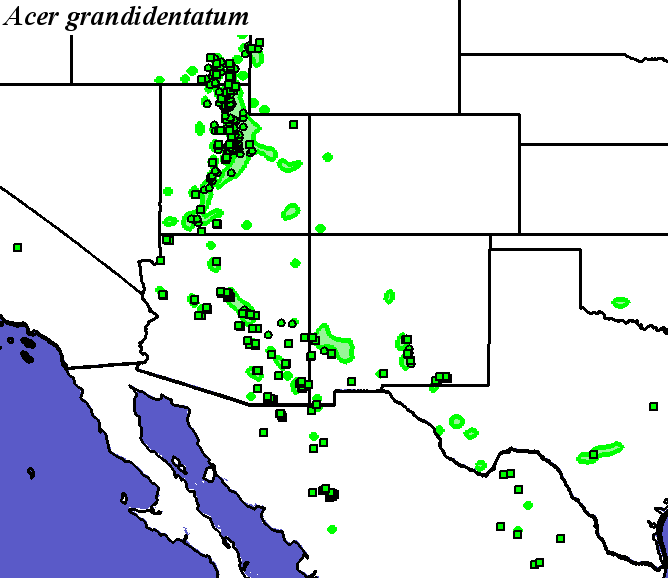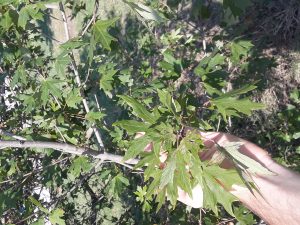Jackson Ray McKeating

Natural range of the Bigtooth Maple.
The tree itself (about 6.7 feet tall)
Unknown species of mushroom, growing under the tree after a moderate rain.
A close-up of the leaves.
For my Travis County Almanac, I’ve decided to focus on the Bigtooth Maple. While the tree itself is largely unremarkable, what makes it a species of interest is the fact that I was able to find it at all. The tree’s range appears to be rather spread out, seemingly depending more on similar eological conditions rather than a particular geographical region to grow. As can be seen from the range map above, the preferred natural habitat of the Bigtooth Maple is mostly in shady canyons and rocky valleys in the western United States. Even the range that extends into Texas is dwarfed by that of, say, Utah. The fact I was able to find a mature, healthy specimen so far from its usual range is something that still strikes me.
This is not, however, the only specimen even on campus. There are two more trees in front of Dujarie hall, both of which are far more mature.
Unfortunately, this tree isn’t a wild specimen. It appears to have been planted here on campus as a sapling. I say that’s an unfortunate thing because it means that I wasn’t truly able to observe something endemic to Travis County. However, the tree does naturally grow in areas a bit further southwest from here, so I’m not too disappointed.
So far, the tree really hasn’t changed or done much, even with these cold snaps. This might be because it’s removed from its natural range, although I’m not very sure.
Considering that this tree in particular has mulch around the trunk, it also raises a question about the fungus I posted. With many fungi, they’ll usually grow on/around a particular species of family of tree. At first I thought this was the case with the mushrooms, but I also can’t deny the possibility that the fungus is just feeding off of the mulch and has nothing to do with the Bigtooth Maple itself. To be fair however, I haven’t seen many other mushrooms like those around town. I had thought of taking a spore print, but as one could see from the picture, the mushrooms are already past their prime, and liable to just rot instead of giving me a print.
One thing about the appearance of this tree that is interesting is that it demonstrates how versatile the climate of central Texas is. Here, one can observe Southern Live Oak, Prickly Pear cactus, and Bigtooth Maple in the same stand of trees. Considering that the maple is often found in areas with rocky/sandy soil with a thin layer of topsoil, it makes sense that it would grow in central Texas, where the topsoil just barely covers the limestone in some places.
To talk more on the tree itself, it’s also known as the Western Sugar maple. It shares its range in much the Rockies with only one other species of maple, the Rocky Mountain Maple. They also generaly don’t grow very tall, about 50 feet at their absolute best. This could probably be attributed to the habitat they generally grow out of, where resources and water can be very short.
However, the most distinguishing feature of the Bigtooth Maple is its world-class fall foliage, which, depending on where the tree grows, strikes out sharply against the conifers and succulents it shares much of its range with. One special place in particular where people travel from miles around to see this phenomenon is right here in Texas. In the Guadalupe Mountains National Park, there’s a spot called McKittrick Canyon. Due to the elevation, shade, and soil type, the Bigtooth Maple thrives in this canyon, and, come November, McKittrick Canyon is lit up with all the colors of fall.
I myself can’t wait for late fall to arrive so I can get pictures of this tree’s fabled leaves and post them in my next Travis County Almanac.
SOURCES:
#1. Kershner, B., & Tufts, C. (2008). National Wildlife Federation field guide to trees of North America. New York: Sterling Pub. Co.
#2. Southwest, T. A. (n.d.). McKittrick Canyon Trail, Guadalupe Mountains National Park. http://www.americansouthwest.net/texas/guadalupe_mountains/mckittrick_canyon.html
#3. Geobabble, T. A. (July 21, 2016). Version 5 Tree Atlas, Acer Grandidentatum.
https://www.geobabble.org/ForeCASTS/html/Acer_grandidentatum_final.elev.html



